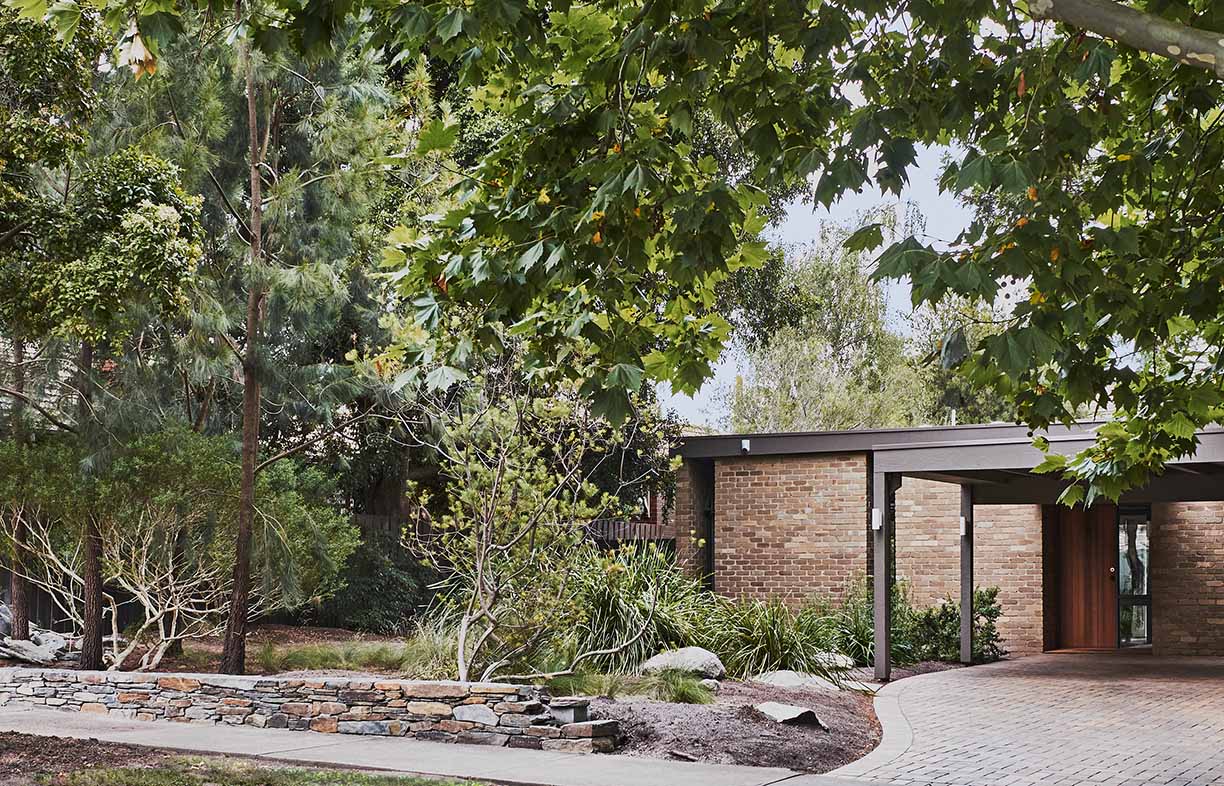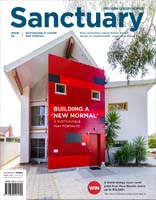Avoiding the winter cold: Housing retrofits as a health intervention

As well as reducing your energy bills and your carbon footprint, upgrading your home’s building envelope can have a positive effect on your health and wellbeing. Health researcher Dr Toby Cumming explains.
Imagine you have just moved into a lovely 1950s weatherboard house somewhere in Australia’s temperate regions. While it has charm, it has barely any insulation, the wind whistles through gaps in the doors and sash windows, and the old gas heater in the living room costs heaps to run. As any dedicated Sanctuary reader knows, there are some pretty straightforward and affordable upgrades you can make to improve the house and its thermal shell. Chances are you are thinking about these upgrades in terms of improving energy efficiency (saving the world’s precious resources) and reducing costs (saving your precious resources). Yet one of the best arguments for the upgrades is that they will improve your health.
The dangers of winter
Back in 1857, William Guy, Cambridge graduate and Fellow of the Royal College of Physicians, had been running his eye over Britain’s data on births, deaths and marriages. Not only a Professor of Forensic Medicine, Guy was also an Honorary Secretary of the Statistical Society, and something in the numbers caught his eye. His insight was a simple one: more people die in winter than at other times of year. It was also durable: to this day, findings of excess cold-related mortality are consistent and robust.
Initially, many attributed excess cold-related mortality to the flu. While the winter flu season does kill, we now know that most cold-related deaths are due to cardiovascular and respiratory disease – conditions like heart attack, stroke, asthma and chronic obstructive pulmonary disease (COPD). Raised blood pressure is one of the primary mechanisms. Cold temperatures constrict blood vessels, essentially narrowing the pipes, leading to increased blood pressure. Cold also increases other vascular risk factors, including blood viscosity and cholesterol levels.
While the effect of cold air on skin is mainly cooling, the effect of cold air on airways is both cooling and drying, which can exacerbate symptoms of asthma and COPD. When cold is twinned with damp, inhalation of mould spores or fragments can inflame the airways and reduce lung function. One of the reasons why these important links between cold indoor temperatures and health have been neglected for so long is that they are often hidden. Much of the population can be experiencing raised blood pressure and compromised lung function without experiencing any symptoms.
While winter cold has been causing deaths for hundreds of years, there has never been a more important time to address the issue than right now. With the world in the grip of the Covid-19 pandemic, access to safe and warm housing is essential. Physical distancing protocols mean that we are confined to home much more than usual. The disastrous economic effects of the pandemic mean that many people will be finding heating their home difficult to afford this winter. If a home is too cold, damp and mouldy, then negative health effects for the householders will inevitably follow. Those who are most vulnerable to the health effects of winter cold – older people and those with chronic health problems, particularly respiratory disease – are exactly the same people who are most vulnerable to the effects of Covid-19.
Let’s get back to your 1950s weatherboard, and consider whether you’re exposing yourself to health risks from cold. We might imagine that a temperate Australian region has less excess winter mortality than, say, Chicago or Berlin. Yet that is not necessarily the case. Research from sub-tropical Taiwan indicates a clear relationship between lower daily temperature and higher mortality, and a large 1997 European study by the Eurowinter Group found, rather counterintuitively, that cold-related mortality was greater in places with warmer winters. For example, the increase in mortality for every degree Celsius below 18 degrees was 2.2 per cent in temperate Athens, but only 0.3 per cent in south Finland. This difference in mortality reflects the thermal efficiency of housing stock: when it was 7 degrees outside, average living room temperature was 21.7 degrees in south Finland but only 19.2 degrees in Athens. It also reflects individual behaviour: when it was 7 degrees outside, warm hats were worn by 72 per cent of Finns but only 13 per cent of Athenians.
Less is known about the Australian context, but there is evidence to suggest that much of our temperature-related mortality is attributable to moderate cold. That is, not the acute ‘exposure’ effects of a day of extreme cold, but the chronic health impacts of living in a slightly-too-cold house over a three-month winter season. This point was demonstrated by a recent study from Melbourne’s Alfred Hospital, which reviewed all recent presentations to their emergency department with hypothermia. The typical profile was not a hiker who had been lost in bushland for days; it was an elderly person with multiple health conditions and few social supports. About four out of five (78 per cent) of all people presenting with hypothermia were found indoors. Temperate parts of the world are not immune from the mortality-increasing effects of winter, and may even have greater susceptibility than colder climate zones.
Retrofits for health: The New Zealand experience
New Zealand has been at the forefront of research into housing, temperature and health. We can learn much from the findings because temperate regions of Australia have a similar profile of climate and housing stock to New Zealand. In 2007, Professor Philippa Howden-Chapman from the University of Otago in Wellington reported results from a randomised trial of insulation in 1,350 low-income households. Average winter bedroom temperatures rose significantly from 13.6 to 14.2 degrees Celsius in the insulated houses, despite energy consumption being only 81 per cent of that in the uninsulated houses. Around half a degree may not seem like much, but the number of people in the intervention group of 550 reporting that their house was cold ‘most of the time or always’ was 398 (72 per cent) before the insulation and only 95 (17 per cent) afterwards.
Compared to the control group, the intervention group reported less poor health, less wheezing, fewer days off school for children and fewer days off work for adults. They had fewer visits to the GP. Importantly, the health benefits of the insulation upgrade were not limited to the physical domain, with emotional health and social functioning both significantly improved in the intervention group. Having a warmer house creates a visitor-friendly environment, fostering connectedness and psychological wellbeing. A year later, a follow up randomised controlled trial of home heating focussed on 409 primary-school-aged children with asthma. Average winter living room temperature was more than a degree higher in intervention than in control houses (17.1 versus 16.0 degrees Celsius). Installation of more effective heating significantly reduced asthma symptoms, days off school, health-care utilisation and pharmacist visits.
Neither of these large New Zealand trials relied on expensive or cutting-edge energy efficiency technology. They demonstrated the power that simple, cheap and widely available retrofit options (fitting insulation, installing a heater) can have as public health interventions. Importantly, the researchers showed that the benefits of the interventions outweighed their costs. In a health economic analysis of the 2007 insulation trial, they found that total monetary value of the benefits (fewer GP and hospital visits, fewer days off school and work, savings in energy use and CO2 emissions) was 1.5 to two times the cost of the retrofit intervention. In other words, for every $1 spent insulating houses, there was a return to society of $1.50 to $2.
Prompted by the compelling research findings, the government initiated the Warm Up New Zealand: Heat Smart Programme. This program involved retrofitting insulation or installing energy efficient heating, or both. The cost-benefit analysis of this program was rigorously conducted, with objectively quantifiable outcomes including metered energy consumption and independently measured health costs. Results were even more impressive than the cost-benefit of the 2007 insulation trial: every $1 spent resulted in a return to society of $3.88. Remarkably, the economic savings were almost entirely due to better health and not to reduced energy use: 99 per cent of the total benefits were health benefits. These results suggest that any evaluation of energy efficiency retrofits that does not consider health co-benefits will vastly underestimate positive impact.

Entering the global consciousness
While New Zealand can boast some of the most comprehensive and well-controlled trials into housing and health, researchers in the UK and US have also been actively pursuing the topic. In 2013, a Cochrane systematic review pulled together all the evidence on housing improvements for health and associated socio-economic outcomes. The conclusion: housing improvement that increases a home’s thermal comfort can lead to health benefits, especially when improvements are targeted to people with inadequate warmth and people with chronic respiratory disease. The evidence indicated that appropriately sized, affordable-to-heat housing is linked to better health, and may promote better social relationships within and beyond the household. In 2018, the World Health Organisation (WHO) released their Housing and Health Guidelines, which included a systematic review of the research evidence and associated recommendations. Classifying the evidence level as ‘strong’, the WHO proposed that, for countries with temperate or colder climates, 18 degrees Celsius is a safe and well-balanced indoor temperature to protect the health of general populations during cold seasons.
Awareness of the links between housing, temperature and health is growing. Organisations that have previously been geared towards energy efficiency and construction standards are pivoting to health. For example, an October 2019 report from the American Council for an Energy-Efficient Economy (ACEEE) was titled ‘Protecting the health of vulnerable populations with in-home energy efficiency: A survey of methods for demonstrating health outcomes’. The authors observed that energy efficiency programs have historically been operated by energy utility providers, which rarely prioritise health outcomes. The ACEEE followed up with a May 2020 report titled ‘Making health count: Monetising the health benefits of in-home services delivered by energy efficiency programs’. They calculated that if existing American ‘weatherisation’ (the US term for housing retrofits) programs targeted four common health risks – asthma, cold exposure, heat exposure, falls – then health savings of $2.9 billion could be made over 10 years.
Victorian Healthy Homes Program
Building on the New Zealand research, the Victorian Healthy Homes Program is a randomised controlled trial that aims to measure and monetise the health benefits of improved warmth and energy efficiency. It is delivered by Sustainability Victoria, in collaboration with the Australian Energy Foundation and the University of Technology Sydney. Participants are low-income householders in western Melbourne and the Goulburn Valley with a complex health or social care need. The intervention is a free home energy upgrade (value up to $3,500) that can include draught proofing, ceiling or sub-floor insulation, efficient heating appliances and window coverings.
Where to from here?
Modern construction codes in Australia mean that newly built homes are typically well-insulated, at least in the ceiling. Wide availability of efficient reverse-cycle air conditioners means that space heating can be relatively low-cost and low-emissions. Australia still has a substantial legacy of older housing stock, though, and will have for decades to come. Again, New Zealand provides the model that we could follow. By late 2015, their Warm Up New Zealand program had insulated more than 286,000 homes. This number included more than 45,000 free insulation retrofits to households at high risk of health conditions related to cold and damp housing. One of the major New Zealand banks recently announced interest-free home loan top-ups for retrofitting insulation and heat pumps, and home loan discounts for properties reaching a certain energy efficiency Star rating. Renters have not been forgotten. In July 2019, the New Zealand Government legislated minimum standards for warmth and energy efficiency across the country’s 600,000 rental properties.
In the temperate areas of south-eastern Australia, retrofitting houses for energy efficiency and thermal comfort will yield clear benefits. Not only will it upgrade the existing housing stock, cut energy bills and reduce emissions, it will improve the health and quality of life of householders, thus lowering the burden on our health system. Mandating minimum standards for warmth and energy efficiency is one way to obtain these benefits. Rolling out a wide-reaching retrofit program is another way. Targeting the program at householders with low income and chronic health problems, at least in the first instance, will maximise its cost effectiveness. Sometimes it is the simplest, most widely applicable interventions that have the greatest impact. With a change in mindset, we can start viewing a home renovation less as a lifestyle choice and more as a public health strategy.
Campaigning for healthy, affordable homes
Renew, the publisher of Sanctuary, is leading a campaign for serious action to make Australia’s homes fit for purpose in the face of the climate emergency.
Everyone in Australia should be able to live in a healthy and affordable home. But when it comes to energy performance, millions of homes around Australia simply aren’t up to scratch. This means high bills, high CO2 emissions, and serious health impacts.
Australia needs to improve the energy performance of both new and existing homes. New homes are still being built to low standards that are lagging behind the rest of the world. We are campaigning for an increase in the minimum energy standard for new homes to at least 7 Stars.
Meanwhile, most homes built before 2005 have an energy efficiency rating of less than 2 Stars. We are pushing for a Covid-19 recovery plan that invests in home retrofits for people on low incomes – creating jobs while addressing our community’s pressing social and environmental needs.
Renew and our partners are doing the work of developing policy solutions and advocating to government, but policy alone is not enough. We can only win real change with community support. Find out more and get involved: www.renew.org.au/crh
- Chapman R, et al (2009). Retrofitting houses with insulation: A cost–benefit analysis of a randomised community trial. Journal of Epidemiology and Community Health.
- Eurowinter Group (1997). Cold exposure and winter mortality from ischaemic heart disease, cerebrovascular disease, respiratory disease, and all causes in warm and cold regions of Europe. Lancet.
- Forcey DS, et al (2019). “Cold and lonely”: Emergency presentations of patients with hypothermia to a large Australian health network. Internal Medicine Journal.
- Gasparrini A, et al (2015). Mortality risk attributable to high and low ambient temperature: A multicountry observational study. Lancet.
- Grimes A, et al (2012). Cost benefit analysis of the Warm Up New Zealand: Heat Smart Programme. Wellington, NZ: Report for the Ministry of Economic Development.
- Hayes S, et al (2019). Protecting the health of vulnerable populations with in-home energy efficiency: A survey of methods for demonstrating health outcomes. Washington, DC: American Council for an Energy-Efficient Economy.
- Hayes S, et al (2020). Making health count: Monetising the health benefits of in-home services delivered by energy efficiency programs. Washington, DC: American Council for an Energy-Efficient Economy.
- Howden-Chapman P, et al (2007). Effect of insulating existing houses on health inequality: Cluster randomised study in the community. BMJ.
- Howden-Chapman P, et al (2008). Effects of improved home heating on asthma in community dwelling children: Randomised controlled trial. BMJ.
- Thomson H, et al (2013). Housing improvements for health and associated socio-economic outcomes. Cochrane Database of Systematic Reviews, CD008657.
- WHO (2018). Housing and Health Guidelines. Geneva: World Health Organisation.
- Yang LT, et al (2018). Associations of ambient temperature with mortality rates of cardiovascular and respiratory diseases in Taiwan: A subtropical country. Acta Cardiologica Sinica.
Further reading
 Ideas & Advice
Ideas & Advice
In praise of Accoya
Native hardwoods are beautiful, strong and durable, but we need to wean ourselves off destructive forestry practices. Building designer and recreational woodworker Dick Clarke takes one hardwood alternative for a test run.
Read more Ideas & Advice
Ideas & Advice
Energy efficiency front and centre: A renovation case study
Rather than starting again, this Melbourne couple opted for a comprehensive renovation of their well laid out but inefficient home, achieving huge energy savings and much improved comfort.
Read more


